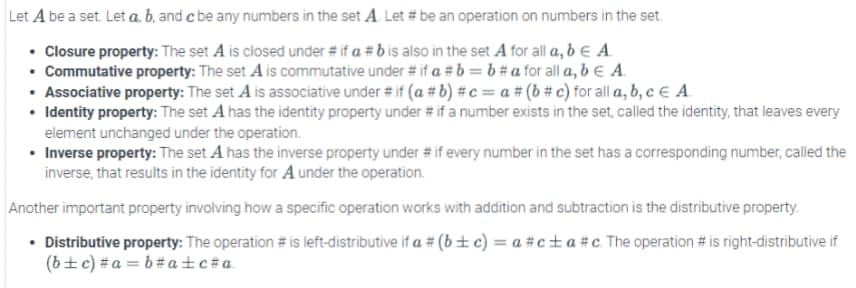Explain each step, excluding those that are labeled as “no justification needed.” For each step, identify the property of the real numbers being used and explain how that property is being applied. I attached a picture of the step I need help with, along with the properties.
Explain each step, excluding those that are labeled as “no justification needed.” For each step, identify the property of the real numbers being used and explain how that property is being applied. I attached a picture of the step I need help with, along with the properties.
Advanced Engineering Mathematics
10th Edition
ISBN:9780470458365
Author:Erwin Kreyszig
Publisher:Erwin Kreyszig
Chapter2: Second-order Linear Odes
Section: Chapter Questions
Problem 1RQ
Related questions
Question
Explain each step, excluding those that are labeled as “no justification needed.” For each step, identify the property of the real numbers being used and explain how that property is being applied.
I attached a picture of the step I need help with, along with the properties.

Transcribed Image Text:=-3x +42 + (-60 +4x)
=-3x + (42 + (-60)) + 4x

Transcribed Image Text:Properties 5.2.1: Properties of sets.
Let A be a set. Let a, b, and c be any numbers in the set A. Let # be an operation on numbers in the set.
• Closure property: The set A is closed under # if a #b is also in the set A for all a, b € A.
• Commutative property: The set A is commutative under # if a # b = b #a for all a, b € A.
• Associative property: The set A is associative under # if (a #b) # c = a # (b # c) for all a, b, c = A.
• Identity property: The set A has the identity property under # if a number exists in the set, called the identity, that leaves every
element unchanged under the operation.
• Inverse property: The set A has the inverse property under # if every number in the set has a corresponding number, called the
inverse, that results in the identity for A under the operation.
Another important property involving how a specific operation works with addition and subtraction is the distributive property.
• Distributive property: The operation # is left-distributive if a # (b±c) = a #c±a #c. The operation # is right-distributive if
(b + c) #a= b #a±c #a.
Expert Solution
Step 1: Given properties are

Trending now
This is a popular solution!
Step by step
Solved in 3 steps with 2 images

Recommended textbooks for you

Advanced Engineering Mathematics
Advanced Math
ISBN:
9780470458365
Author:
Erwin Kreyszig
Publisher:
Wiley, John & Sons, Incorporated

Numerical Methods for Engineers
Advanced Math
ISBN:
9780073397924
Author:
Steven C. Chapra Dr., Raymond P. Canale
Publisher:
McGraw-Hill Education

Introductory Mathematics for Engineering Applicat…
Advanced Math
ISBN:
9781118141809
Author:
Nathan Klingbeil
Publisher:
WILEY

Advanced Engineering Mathematics
Advanced Math
ISBN:
9780470458365
Author:
Erwin Kreyszig
Publisher:
Wiley, John & Sons, Incorporated

Numerical Methods for Engineers
Advanced Math
ISBN:
9780073397924
Author:
Steven C. Chapra Dr., Raymond P. Canale
Publisher:
McGraw-Hill Education

Introductory Mathematics for Engineering Applicat…
Advanced Math
ISBN:
9781118141809
Author:
Nathan Klingbeil
Publisher:
WILEY

Mathematics For Machine Technology
Advanced Math
ISBN:
9781337798310
Author:
Peterson, John.
Publisher:
Cengage Learning,

